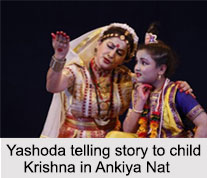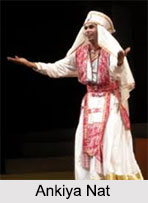 Ankiya Nat is performed in village Namghars and Satra premises to preserve its traditional importance. This dance is a form of drama that originated in the year 1449 and it is still popular among the people in every region of Assam. Ankiya Nat is a form of religious theatre dance drama created by Shankaradeva. "Ankiya" means "act" or "episode" and "Nat" means "drama". Therefore, "Ankiya Nat" means a "one-act drama". Shankaradeva created Ankiya Nat. Ankiya Nat is Vaisnavite in content and character. It is one of the oldest of its type.
Ankiya Nat is performed in village Namghars and Satra premises to preserve its traditional importance. This dance is a form of drama that originated in the year 1449 and it is still popular among the people in every region of Assam. Ankiya Nat is a form of religious theatre dance drama created by Shankaradeva. "Ankiya" means "act" or "episode" and "Nat" means "drama". Therefore, "Ankiya Nat" means a "one-act drama". Shankaradeva created Ankiya Nat. Ankiya Nat is Vaisnavite in content and character. It is one of the oldest of its type.
History of Ankiya Nat
The growth of Ankiya Nat was influenced by the earlier practice of reciting "kavyas" and "sastras" in social and religious congregations. Prior to the composition of the Ankiya Nat, Srimanta Shankaradeva himself had written a set of "kavyas", which were used in such recitals. He realised the effectiveness of the dramatic medium in propagating his cult effectiveness greater than that of merely reciting the story as in the "kavyas" whose appeal was aural and not visual.
Though the Ankiya plays have largely been developed out of native and indigenous materials, the influence on it of the Sanskrit drama is also noticeable to a great extent. Srimanta Shankaradeva himself styled these dramatic compositions "nat" and "natakas" after the Sanskrit names. Other tides used by the Vaisnava poets for this type of plays are Yatra, Nrta, and Anka. The shorter plays of Madhavadeva are called "Jhumura". The more popular name, however, is Ankiya Nat. Ankiya nat is a generic term in Assamese and means a dramatic composition in a single act depicting the articles of Vaisnava faith.
Features of Ankiya Nat
 The complete play is performed from beginning to end, without any prime break between the scenes, the Sutradhara filling in the possible gaps with his own brand of dialogue. Scenes join fine with the simple rural folk like eating, killing etc. The drama or Nat includes a lot of songs and dances as well. Basically, this is a single act drama, in which several characters get involved giving active role to only one of the performers. The Sutradhara of an Ankiya Nat, though not an active character of the play has an important role, since he recites slokas, sings dances and explains every act of the play in prose. This dance is a classic mixture of music and words, which were interspersed by small dialogues and descriptive matter by a sutradhara for each time.
The complete play is performed from beginning to end, without any prime break between the scenes, the Sutradhara filling in the possible gaps with his own brand of dialogue. Scenes join fine with the simple rural folk like eating, killing etc. The drama or Nat includes a lot of songs and dances as well. Basically, this is a single act drama, in which several characters get involved giving active role to only one of the performers. The Sutradhara of an Ankiya Nat, though not an active character of the play has an important role, since he recites slokas, sings dances and explains every act of the play in prose. This dance is a classic mixture of music and words, which were interspersed by small dialogues and descriptive matter by a sutradhara for each time.
Elements of Ankiya Nat
The participants perform this art form by wearing large masks of gods, goddesses, demons and animals. The masks used for plays are huge in size, sometimes reaching up to the waist of the performer. Some masks are even of size up to 15 feet in height, which give a huge look to the overall theatre performance.
Artists are required to give appropriate movement to their individual masks, since they have to enter inside a mask and take overall weight on their shoulders. The masks contain thin clothes in the front to enable the artists to see through them. Due to the heavy weight and almost immobile nature of these masks, the characters depicted by them are usually restricted to demons and snakes having very limited movements.
There are huge statues made of bamboo and wrapped with papier-mache painted to symbolize demons and animals. Sometimes, the shapes are at least 15 feet high and manipulated by quite a lot of actors at once.
Performance of Ankiya Nat
Performance of Ankiya Nat begins with an elaborate custom of drumming, songs and dances commencing at the doorway of lights which are constructed on the acting area, opposite to the holy room. Special songs are sung to pay tribute to the Lord Krishna. The actual performance begins with Lord Krishna`s performance, which is a solo dance across the shrine, the main attraction of the drama. The narrator is constantly moving in and out of the stage explaining the play and making the whole event more exciting. The stories and the central idea of the play are generally taken from the life-stories of Lord Krishna. The instruments are played with embellished hand movements and in two paces called "Saru-Dhemali" and "Bor-Dhemali". After the introduction, the storyteller, or "Sutradhar", enters the stage and begins the real performance. However the Ankiya Natas of contemporary times are enacted on stage in the theatre halls and other public places too.



















